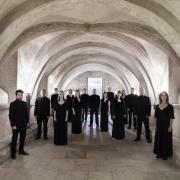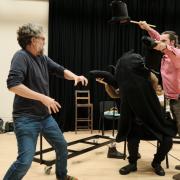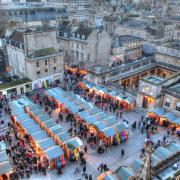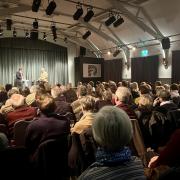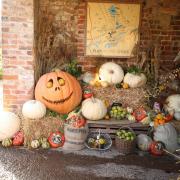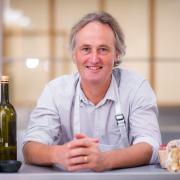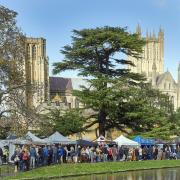Promotional Feature The medieval 14th century Abbot’s Kitchen reopened in 2014 after major conservation work.

Described by historians as an architectural masterpiece, it is an extremely rare example and one of the best preserved medieval kitchens in Europe. Experts say along with the work currently ongoing on the Lady Chapel, the conservation is the most significant for a century.
It was closed last year to allow extensive conservation work to be carried out and now the kitchen has been redisplayed to give visitors a better idea of how it was used in the early Tudor period, when Glastonbury Abbey was one of the wealthiest and most influential abbeys in the country.

Janet Bell, Director, said: “Along with the Lady Chapel, this has been the most significant and comprehensive programme of conservation at the Abbey in the last 100 years.
“The Abbot’s Kitchen is surviving evidence of the wealth and influence of Glastonbury Abbey. As head of the richest monastery in England after Westminster, the abbot lived and entertained in considerable splendour.

“The conservation programme was informed by a survey of the kitchen, undertaken in 2013. This was the first detailed survey since AWN Pugin recorded the building in the 1830s. The latest technology was used to produce a three dimensional digital model, which helped us to understand the building’s complex dimensions, volume and structure.
“Vulnerable stonework was identified and required a full programme of stabilisation by professional conservators. Archaeological recording and analysis was also carried out alongside the conservation and has increased our knowledge and understanding of the building’s history.
“Peter Brears, a specialist in traditional English cookery, has advised on the new display, using historical evidence found inside the kitchen itself and from his extensive knowledge of other medieval kitchens. He found that the remains of two stone piers in the north and south walls inside the kitchen suggested there may have been an arcaded gallery from which the kitchener or head cook could supervise the staff – the Gordon Ramsay of his day.
“A modern gantry has been installed between the piers to indicate the position and size of the gallery. It also carries the lighting and overhead heaters to prevent any damage to the medieval walls. It has not been possible to reconstruct the gallery as it might have been as we have no evidence for its original appearance or construction. Authentic reproductions of kitchen equipment of the period will be used to illustrate to visitors how and what was cooked.
“The project has been part of a wider programme of conservation which also includes the Lady Chapel, Crypt and Galilee. The work is being funded by the Abbey’s Rescue Our Ruins Appeal, Viridor Credits Environmental Company and other grants.”
The Star and Dove Tavern in Bristol which specialises in historic dishes has adopted the Abbey’s Rescue Our Ruins Appeal as Tim Denny, joint landlord explains.
“We are a nation built upon foreign empires, colonization, shared culture and a truly international history.
“Our gastronomy is an amalgamation of these events and experiences, which has ensured this exceptionally small Isle is a melting pot of some of the most interesting and culinary diverse fusion cookery in Europe.
“For this reason we deem the rejuvenation of the Glastonbury Abbey kitchen as an essential component in connecting the past with the present and a triumph for not just the South West but all of Great Britain.
“We have been sifting through our books of Middle English, High French and Latin as we have put the finishing touches to our new downstairs tavern menu.
“Every dish has been taken from one of the first registered cook books of Britain “The Forme of Cury, 1390”. Incidentally one can only assume that many of the ingredients, flavours and techniques used would have been extremely similar to what would have been delivered at the Glastonbury Abbey kitchens given the close proximity of the era, give or take 20 or 30 years.
“Dishes include fire roasted mallard (wild duck) with black pudding bread sauce and pheasant cooked with Riesling, pine nuts and dates. These combinations are extremely pleasant to eat and not as alien as one might think.”
A cook book to coincide with the reopening of the Abbey has been produced featuring recipes from celebrity chefs including Michelin starred Josh Eggleton, Tom Kerridge and Martin Blunos as well as Rick Stein, the Hairy Bikers, and Michael Caines.
It is on-sale at the Abbey Shop for £5 with all proceeds to the Rescue Our Ruins Appeal. Entry to the Kitchen is included in the Abbey’s normal admission price.
Interesting facts
The Abbot’s Kitchen is square in plan, but the four corner ?replaces create an eight-sided interior. The massive stone roof rises to a tall two-tiered lantern. The kitchen is constructed of local blue lias and ‘Tor burr’stone. The ?nely dressed masonry was brought from the abbey’s quarries at Doulting, near Shepton Mallet.
The lantern was cleverly constructed to provide essential ventilation to the kitchen, drawing in fresh air and expelling smoke, smells and steam through louvres (ventilation slats).
The kitchen is now missing its four chimneys, one for each corner ?replace, which would have given its medieval roof a very different appearance.
The Abbot’s Kitchen was built at some time between 1320 and 1370, forming part of a splendid suite of rooms for the abbot and his guests. It was linked on the north to a grand new hall, the south west corner still standing today. Other buildings included the abbot’s house, a chapel and guest accommodation.
Receiving guests, whether poor pilgrims or rich visitors, was an important part of Benedictine life. Like any nobleman, the abbot welcomed high ranking visitors and even royalty. When Edward III and Queen Philippa visited in 1331, the abbey spent £800 (about £350,000 today) on food, accommodation and ceremonies. Meals for the abbot and his guests were prepared in the Abbot’s Kitchen, while the monks had their own kitchen. Although the Benedictine diet was essentially vegetarian and red meat was strictly forbidden, the food served at the abbot’s table was far more elaborate than that permitted in the monks’ dining hall.
On feast days special meals and delicacies were served at the abbot’s table. Accounts submitted to Henry VIII in 1538 record that on Lady Day (25th March) the cook provided six salted salmon with sugar, pepper and saffron, on Easter Sunday six lambs and Easter eggs and at Corpus Christi (a moveable feast in May or June) meat pasties, spices and malted barley.
The Abbot’s Kitchen escaped destruction when the abbey was dissolved in 1539. Its survival may be due to the building’s domestic, rather than religious, character. Perhaps it was because it lacked a lead roof, making it less valuable to Henry VIII’s commissioners, or simply that it was a useful building.








